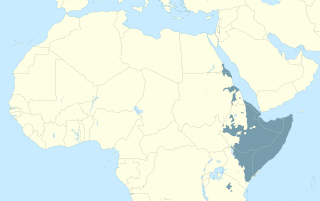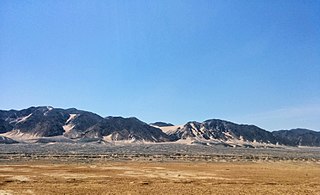Related Research Articles

The Ababda are an Arab or Beja tribe in eastern Egypt and Sudan. Historically, most were Bedouins living in the area between the Nile and the Red Sea, with some settling along the trade route linking Korosko with Abu Hamad. Numerous traveler accounts from the nineteenth century report that some Ababda at that time still spoke Beja or a language of their own, hence many secondary sources consider the Ababda to be a Beja subtribe. Most Ababda now speak Arabic and identify as an Arab tribe from the Hijaz. The Ababda have a total population of over 250,000 people.

The Cushitic languages are a branch of the Afroasiatic language family. They are spoken primarily in the Horn of Africa, with minorities speaking Cushitic languages to the north in Egypt and Sudan, and to the south in Kenya and Tanzania. As of 2012, the Cushitic languages with over one million speakers were Oromo, Somali, Beja, Afar, Hadiyya, Kambaata, and Sidama.

Nubians are a Nilo-Saharan speaking ethnic group indigenous to the region which is now northern Sudan and southern Egypt. They originate from the early inhabitants of the central Nile valley, believed to be one of the earliest cradles of civilization. In the southern valley of Egypt, Nubians differ culturally and ethnically from Egyptians, although they intermarried with members of other ethnic groups, especially Arabs. They speak Nubian languages as a mother tongue, part of the Northern Eastern Sudanic languages, and Arabic as a second language.

The Beja people are a Cushitic ethnic group native to the Eastern Desert, inhabiting a coastal area from southeastern Egypt through eastern Sudan and into northwestern Eritrea. They are descended from peoples who have inhabited the area since 4000 BC or earlier, although they were Arabized by Arabs who settled in the region. They are nomadic and live primarily in the Eastern Desert. The Beja number around 1,900,000 to 2,759,000.
Beja is an Afroasiatic language of the Cushitic branch spoken on the western coast of the Red Sea by the Beja people. Its speakers inhabit parts of Egypt, Sudan and Eritrea. In 2022 there were 2,550,000 Beja speakers in Sudan, and 121,000 Beja speakers in Eritrea according to Ethnologue. As of 2023 there are an estimated 88,000 Beja speakers in Egypt. The total number of speakers in all three countries is 2,759,000.

The Meroitic language was a language of uncertain linguistic affiliation spoken in Meroë during the Meroitic period and became extinct about 400 AD. It was written in two forms of the Meroitic alphabet: Meroitic Cursive, which was written with a stylus and was used for general record-keeping; and Meroitic Hieroglyphic, which was carved in stone or used for royal or religious documents. It is poorly understood, owing to the scarcity of bilingual texts.
Medjay was a demonym used in various ways throughout ancient Egyptian history to refer initially to a nomadic group from Nubia and later as a generic term for desert-ranger police. They were sometimes confused with the Pan-Grave culture.

Old Nubian is an extinct Nubian language, attested in writing from the 8th to the 15th century AD. It is ancestral to modern-day Nobiin and closely related to Dongolawi and Kenzi. It was used throughout the kingdom of Makuria, including the eparchy of Nobatia. The language is preserved in more than a hundred pages of documents and inscriptions, both of a religious nature, and related to the state and private life, written using adaptation of the Coptic alphabet.

The Meroitic script consists of two alphasyllabic scripts developed to write the Meroitic language at the beginning of the Meroitic Period of the Kingdom of Kush. The two scripts are Meroitic Cursive, derived from Demotic Egyptian, and Meroitic Hieroglyphs, derived from Egyptian hieroglyphs. Meroitic Cursive is the most widely attested script, constituting ~90% of all inscriptions, and antedates, by a century or more, the earliest surviving Meroitic hieroglyphic inscription. Greek historian Diodorus Siculus described the two scripts in his Bibliotheca historica, Book III (Africa), Chapter 4. The last known Meroitic inscription is the Meroitic Cursive inscription of the Blemmye king, Kharamadoye, from a column in the Temple of Kalabsha, which has recently been re-dated to AD 410/ 450 of the 5th century. Before the Meroitic Period, Egyptian hieroglyphs were used to write Kushite names and lexical items.

Lower Nubia is the northernmost part of Nubia, roughly contiguous with the modern Lake Nasser, which submerged the historical region in the 1960s with the construction of the Aswan High Dam. Many ancient Lower Nubian monuments, and all its modern population, were relocated as part of the International Campaign to Save the Monuments of Nubia; Qasr Ibrim is the only major archaeological site which was neither relocated nor submerged. The intensive archaeological work conducted prior to the flooding means that the history of the area is much better known than that of Upper Nubia. According to David Wengrow, the A-Group Nubian polity of the late 4th millenninum BCE is poorly understood since most of the archaeological remains are submerged underneath Lake Nasser.

The Kingdom of Kerma or the Kerma culture was an early civilization centered in Kerma, Sudan. It flourished from around 2500 BC to 1500 BC in ancient Nubia. The Kerma culture was based in the southern part of Nubia, or "Upper Nubia", and later extended its reach northward into Lower Nubia and the border of Egypt. The polity seems to have been one of a number of Nile Valley states during the Middle Kingdom of Egypt. In the Kingdom of Kerma's latest phase, lasting from about 1700 to 1500 BC, it absorbed the Sudanese kingdom of Sai and became a sizable, populous empire rivaling Egypt. Around 1500 BC, it was absorbed into the New Kingdom of Egypt, but rebellions continued for centuries. By the eleventh century BC, the more-Egyptianized Kingdom of Kush emerged, possibly from Kerma, and regained the region's independence from Egypt.

Itbāy or ʿAtbāy is a region of southeastern Egypt and northeastern Sudan. It is characterized by a chain of mountains, the Red Sea Hills, running north–south and parallel with the Red Sea. The hills separate the narrow coastal plain from the Eastern Desert.
The Tunjur people are a Sunni Muslim ethnic group living in eastern Chad and western Sudan. In the 21st century, their numbers have been estimated at 175,000 people.

The Blemmyes were an Eastern Desert people who appeared in written sources from the 7th century BC until the 8th century AD. By the late 4th century, they had occupied Lower Nubia and established a kingdom. From inscriptions in the temple of Isis at Philae, a considerable amount is known about the structure of the Blemmyan state.

The Kingdom of Kush, also known as the Kushite Empire, or simply Kush, was an ancient kingdom in Nubia, centered along the Nile Valley in what is now northern Sudan and southern Egypt.
The geographical region of ancient Nubia covers the area from the First Cataract at Aswan in the north, to the Blue and White Niles at Khartoum in the south, and adjacent deserts. The region includes the Nile Valley of lower Egypt and nowadays Sudan. The earliest history of Nubia dates to the Paleolithic period, and the civilization of ancient Nubia developed alongside ancient Egypt on the Nile valley. Both Egypt and Nubia are characterized by their distinct cultural identities and had lots of interactions—military, political, and commercial—throughout history. Prior to Roman contact, Kush had trade relations with Ptolemaic Egypt. The early interaction between Rome and the kingdom of Kush in Nubia was full of tensions and conflicts before Caesar Augustus established a peace treaty with Kush. Nubia thereby flourished for nearly three centuries through trade with Roman Egypt. Archaeological excavations and written accounts by Classical authors such as Strabo, Pliny the Elder, and Diodorus are important sources of information about Roman relations with Nubia.
The Bible was translated into Old Nubian during the period when Christianity was dominant in Nubia. Throughout the Middle Ages, Nubia was divided into separate kingdoms: Nobadia, Makuria and Alodia. Old Nubian was the standard written form in all three kingdoms. Of the living Nubian languages, it is modern Nobiin which is the closest to Old Nubian and probably its direct descendant.

Cushitic-speaking peoples are the ethnolinguistic groups who speak Cushitic languages natively. Today, the Cushitic languages are spoken as a mother tongue primarily in the Horn of Africa, with minorities speaking Cushitic languages to the north and south in Egypt, Sudan, Kenya, and Tanzania.
Proto-Cushitic is the reconstructed proto-language common ancestor of the Cushitic language family. Its words and roots are not directly attested in any written works, but have been reconstructed through the comparative method, which finds regular similarities between languages not explained by coincidence or word-borrowing, and extrapolates ancient forms from these similarities.

The Blemyomachia is an anonymous fragmentary ancient Greek epic poem of the 4th or 5th century AD. It describes a victory in battle of the Romans over the Blemmyes. Only 161 complete or partial lines are preserved from three separate papyri.
References
- ↑ Quibell, J.E. (1909). Excavations at Saqqara (1907–1908). Cairo: L'Institut Français d'Archéologie Orientale. p. 109.
- ↑ Browne, Gerald (2003). Textus Blemmyicus aetatis christianae. Champaign.
{{cite book}}: CS1 maint: location missing publisher (link) - ↑ Browne, Gerald (March 2004). "Blemmyes and Beja". The Classical Review. 54 (1): 226–228. doi:10.1093/cr/54.1.226.
- ↑ Wedekind, Klaus (2010). "More on the Ostracon of Browne's Textus Blemmyicus". Annali: Dipartimento Asia, Africa e Mediterraneo, Sezione Orientale. 70: 73–81.
- ↑ Satzinger, Helmut (1992). "Die Personennamen von Blemmyern in koptischen und griechischen Texten: orthographische und phonetische Analyse". In Ebermann, E.; Sommerauer, E.R.; Thomanek, K.E. (eds.). Komparative Afrikanistik. Sprach-, geschichts- und literaturwissenschaftliche Aufsätze zu Ehren von Hans G. Mukarovsky anlässlich seines 70. Geburtstags (in German). Vienna: Afro-Pub. pp. 313–324. ISBN 3850430618.
- ↑ Satzinger, Helmut (2012). The Barbarian Names on the Ostraca from the Eastern Desert (3rd Century CE). 'Inside and Out: Interactions between Rome and the Peoples on the Arabian and Egyptian Frontiers in Late Antiquity (200–800 CE). Ottawa.
- ↑ Rilly, Claude (2019). "Languages of Ancient Nubia". In Raue, Dietrich (ed.). Handbook of Ancient Nubia. Berlin: De Gruyter. pp. 133–134. ISBN 978-3-11-041669-5.